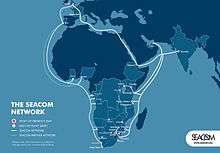SEACOM (African cable system)
| SEACOM | |
|---|---|
 | |
|
Owners: 76.25 percent African investors; 23.75 percent Herakles Telecom[1] | |
|
Landing points see the landing points section
| |
| Design capacity | 12 Tbit/s[2] |
| Currently lit capacity | 500 Gbit/s[3] |
| Technology | Fiber optics |
| Date of first use | July 23, 2009 |

SEACOM is a submarine cable operator with a network of submarine and terrestrial high-speed fibre-optic cable that serves the east and west coasts of Africa. SEACOM’s reach extends into Europe and the Asia-Pacific via India. The Pan-African network uses bundled backhaul, open access Points of Presence (PoPs) and global partnerships to provide end-to-end wholesale and enterprise connectivity around the world for African and international network and content operators.
In-service since July 2009, SEACOM has increased the availability of international bandwidth ten-fold, and more so in many of Africa’s most under-served nations. The only privately funded and truly neutral carrier in its market, SEACOM also offers a comprehensive suite of IP/MPLS (Internet Protocol & Multi-Protocol Label Switching) and clear channel services to the wholesale and enterprise segments.
Cable structure and technology
Express fibre pairs are provided from Kenya to France to a PoP in Marseille, as well as from Tanzania to India into a PoP in Mumbai.
SEACOM has also built an on-net, European network, managed and operated by themselves, to deliver a mixture of Transport and IP/MPLS services to/from Africa from/to the following cities in Europe:
- Amsterdam, Netherlands
- Frankfurt, Germany
- London, United Kingdom
- Marseille, France
- Slough, United Kingdom
- Stockholm, Sweden
Through partnership with 3rd party networks in Europe, SEACOM are able to deliver services to other locations in Europe not covered in the list of cities, above.
The SEACOM cable is deployed with a mixture of double armour cable, single armour cable, special protection cable (with a metallic wrap below the insulator, rather than steel wires), and lightweight cable without armour, used in deep waters. Shallower water cable typically has more protective armour than offshore, deeper cable.
The cable is a loose tube design that determines the amount and relative location along the transmission path of each type of fibre. Multiple fibre types are used in the cable: dispersion shifted and non-dispersion shifted.
The repeaters are optical amplifier repeaters, using erbium-doped amplifiers. There are over 150 repeaters in the SEACOM system. They are spaced along the cable many tens of kilometres apart with the distance between repeaters varying depending on the segment in the system. Repeater spacing is determined by a variety of factors, including the transmission capacity of the fibres in the cable and the distance between SLTE's (Submarine Line Terminal Equipment).
On 23 July 2009, the 17,000 kilometres (11,000 mi) sub-sea fibre optic cable began operations, providing the eastern and southern African countries of Djibouti, Kenya, Tanzania, Mozambique, and South Africa with high-speed Internet connectivity to Europe and Asia. The cable was officially switched on in simultaneous events held across the region, in Mombasa and Dar Es Salaam.
Upon being switched on, the owners of the cable stated that it would "reduce Internet costs by up to 95% to wholesale customers while providing a far greater speed of Internet connection. It may take a long time for the benefits to reach ordinary citizens, particularly those who live in remote rural areas."
Project funding
SEACOM is privately funded, and approximately 75 percent African-owned. Initial private investment in the SEACOM project was US$375 million: $75 million from the developers, $150 million from private South African investors, and $75 million as a commercial loan from Nedbank (South Africa). The remaining US$75 million was provided by Industrial Promotion Services (IPS), which is the industrial and infrastructure arm of the Aga Khan Fund for Economic Development. The IPS investment was funded by $15 million in equity, and a total of US$60.4 million in debt from the Emerging Africa Infrastructure Fund and the FMO.[4]
Current ownership structure is as follows: Industrial Promotion Services with 26.56 percent, Remgro Limited 25 percent, whilst Convergence Partners and Shanduka hold 12.5 percent each. Herakles Telecom LLC holds a 23.44 percent stake in the project.[5]
The cable is variously described as a $600 and a $650 million project, and has seen a number of upgrades to landing station infrastructure, national backhaul and increases to carrying capacity, with an increase to 2.6Tbit/s in May 2012,[6] and then to 12Tbit/s in 2014.[7]
Landing points

The cable landing points are:
- Marseille, France
- Djibouti
- Mombasa, Kenya
- Dar Es Salaam, Tanzania
- Maputo, Mozambique
- Mtunzini, South Africa
- Mumbai, India
In addition, as of May 2012, backhaul solutions allow onwards connectivity from the coastal landing points to:
- London, United Kingdom
- Johannesburg, South Africa
- Cape Town, South Africa
- Durban, South Africa
- Kijitonyama, Tanzania
- Nairobi, Kenya
- Kampala, Uganda
- Kigali, Rwanda
- Dawele, Djibouti border with Ethiopia
- Galafi, Djibouti border with Ethiopia
- Beitbridge, South African border with Zimbabwe
- Mutare, Mozambique border with Zimbabwe
- Onseepkans, South African border with Namibia
- Ramatlabama, South African border with Botswana
- Mahamba, South African border with Swaziland
- Caprivi, Namibia border with Zambia
SEACOM Partner Network landing points include:
- Yzerfontein, South Africa
- Swakopmund, Namibia
- Luanda, Angola
- Muanda, DRC
- Pointe Noir, Congo
- Lagos, Nigeria
- Accra, Ghana
- Seixal, Portugal
- Fujairah, UAE
Social and economic implications
East Africa has been one of the last significant regions lacking broadband Internet access. Broadband access is expected to narrow the digital divide between Africa and wealthier geopolitical regions and is also expected to be a major advantage to many local industries, particularly those based on offshoring.
See also
References
External links
| Wikimedia Commons has media related to SEACOM (African cable system). |
- SEACOM website
- Video footage (WMV, 17.6 MB)